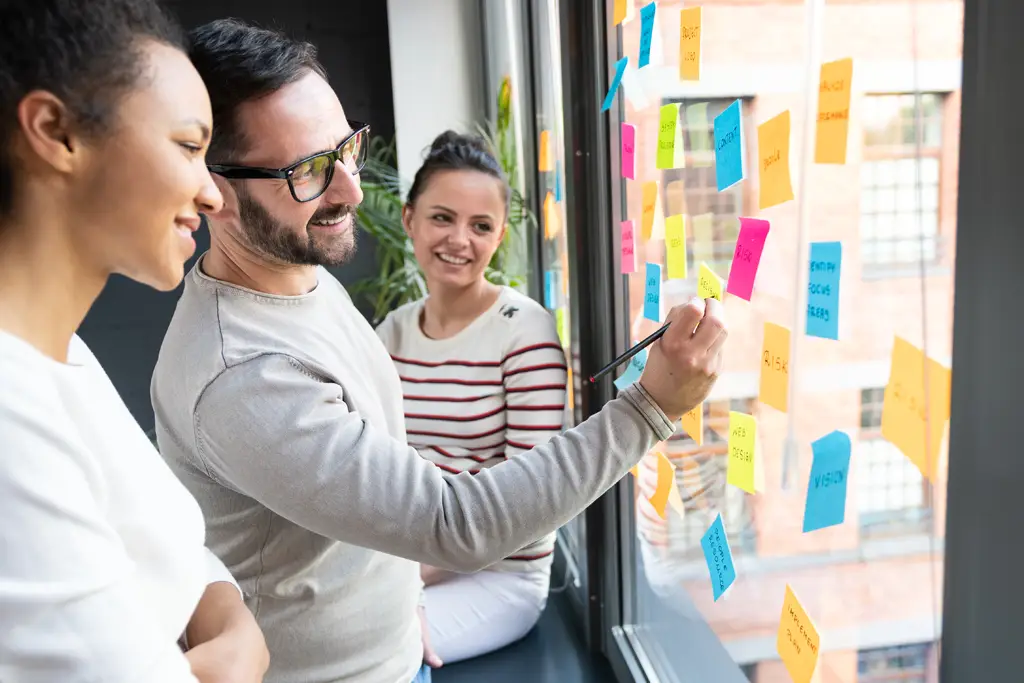Delivering a great digital user experience is crucial for businesses today. However, it often requires a deep dive into understanding user needs, pain points, and the overall customer journey. In this article, we’ll take a behind-the-scenes look at how the UX team at UpTop conducted a 3-day Discovery Workshop to uncover insights and develop solutions for improving the digital experience of a client.
Our client was using an analog process for their customers’ paperwork. They needed to incorporate new technologies to modernize their user experience. The UpTop team utilized a design thinking approach, including stakeholder interviews, user research, and collaborative ideation sessions, to redefine the problem, uncover hidden challenges, and ultimately present a strategic plan for enhancing the client’s digital portal.
This case study provides a detailed overview of the Discovery Workshop process and each day’s key activities and outcomes. We also look at the valuable lessons learned about aligning business goals with user needs to drive impactful UX improvements. By sharing this real-world example, we hope to inspire other teams to embrace a user-centric, research-driven approach to digital experience design.

Research and Discovery
The Discovery Phase is the first step in the UX strategy and design process. This is where foundational user research occurs. The goal during this phase is to learn as much as possible about the client’s business, objectives, users, and competitors.
Activities during this phase can include (but are not limited to):
- Stakeholder Interviews
- Focus Groups
- Heuristic Evaluations
- Card Sorting
- Surveys
- Personas
- User Journeys
- Analytics
- Task Analysis
- Ideation Workshop
Goals of UpTop’s 3-day Discovery Workshop:
- Identify users and map the user journey
- Determine the business and user needs
- Uncover pain points
- Bring together stakeholders
- Define the project scope
- Align business goals with the solutions presented
We incorporated some of Google Venture’s Design Sprint approaches into this process. A sprint can help shortcut the endless debate cycle across teams. This tends to be necessary to stay on track since our 3-day Discovery Phase is done in a short period of time. Keeping the discussions succinct and purposeful made this workshop phase more effective. It provided a solid framework from which to work and kept us on task.
Starting With Data
After aligning business goals, our team performed both quantitative and qualitative research. This is what we call a UX Analysis. In this case, we analyzed the customer’s website. We started by assessing customer surveys and chat logs which gave insight into the Voice of Customer (VOC), meaning their goals, expectations, and frustrations.
To fill in the gaps, we also interviewed customer service representatives. This further exposed the challenges customers and internal teams faced using the portal. This data allowed us to review not only the UX but also the employee experience to create a better overall customer experience.
By applying user behavior monitoring software to their portal and conducting a deep dive into Google Analytics, we were able to see where users were dropping off most frequently and which pages had the lowest traffic. A task analysis also revealed user flows, user goals, and pain points in navigating the portal.
These findings gave us direction for the key parts of the portal to focus on, including information architecture and discoverability. All of the combined research helped us to prioritize our focus for the 3-day Discovery Workshop.
Measuring Your Audience
We invited eight stakeholders from our client’s business to participate in the workshop. To make a discovery workshop successful, it’s important to have a mix of stakeholders. This can include people who directly work with the product like software engineers, developers, and customer service leads, to domain experts, like a business analyst and CTO.
From our team, we had two UX designers to co-facilitate the workshop, a UX researcher, a director of business development, and a project manager who kept track of time and took notes/photos. We had a core team of participants who attended each day and others who came just for the exercises where their participation was most important.

Discovery Workshop Summary
Uncover the Vision: Day 1
The goal of Day 1 was to:
- Set the long-term business goals and vision
- Identify key problem areas to address in the workshop exercises
- Map the customer journey, including their goals and frustrations
- Gain insights from internal experts to help guide the focus areas
Schedule:
1. Icebreakers
2. Set the Long-term Goal
To identify a clear long-term goal, we asked the group questions like:
- Why do we have a client portal?
- What problems does it solve today?
- What is the vision for the future?
- How will we measure success?
3. Open Questions
Less specifically, we also asked the group what questions they hope to answer together in the next few days.
4. Customer Map
We created a map of customer touchpoints, actions, and users. We focused on flows integral to the user’s success and happiness within the portal. This helped us understand their goals and how they felt along each step of the way.
5. Ask the Experts
This included a short 5-minute presentation and Q&A with each expert representative. Questions we answered together included:
- What will make this project successful?
- What’s our unique advantage or opportunity?
- What’s the biggest risk?
6. Introduction to How Might We (HMW) Notes
Each person in the sprint wrote their own notes, one at a time, on a Post-It with the question, “How Might We…?” For example, one person asked, “How might we simplify notification development efforts?”
7. Review and Wrap Up

Brainstorming Solutions: Day 2
The goal of Day 2 was to explore inspiring examples of products and services, sketch solutions, present solutions, and vote on solutions to prioritize for discussion on Day 3.
Demo Examples
To kick off the ideation process, the team was asked to research and share inspiring examples of products or services that could provide solutions to the problems identified on Day 1. Participants were encouraged to look beyond their own industry for innovative ideas.
Each person spent 20 minutes researching potential examples, such as how Facebook handles user privacy and permissions, or the dashboard interface design of Paychex.
The team then took turns presenting their “lightning demos”, 3-minute overviews highlighting the key features or concepts that could apply to the client’s challenges. The UpTop team captured notes on the whiteboard to review after all the demos were completed.
This exercise helped the group think creatively and exposed them to a diverse range of potential solutions they may not have considered otherwise. It set the stage for the collaborative sketching and ideation that would happen next.
Sketching Solutions
After reviewing the inspiring demo examples, the team moved into a collaborative sketching exercise to generate potential solutions. Each group chose a specific focus area to tackle, based on the “How Might We” themes or pain points identified in the customer journey map on Day 1.
Some of the key areas the teams targeted included:
- Notifications
- Invite/add member modal
- User profile dashboard
After the groups presented their sketched concepts, everyone was given five sticker votes to place on the ideas they found most interesting or impactful. This “heat map” exercise allowed the team to quickly identify the most promising solutions that should be prioritized for further exploration.
The team then reviewed the “hot spot” areas, the concepts with the most votes, which helped set the direction for the final day of the workshop.

Prioritizing Tasks: Day 3
The goals for the final day of the Discovery Workshop were to:
- Determine and prioritize the impact vs. effort of the UX solutions presented
- Storyboard those solutions to expose any gaps or missing elements
- Review and revise any open questions from Day 1
Impact vs. Effort
As a team, we prioritized the UX solutions on a grid of low to high impact vs. low to high effort. We reminded the team that the impact of each feature should be directly tied to the customer’s high-level business goals and success metrics. The team then voted on the impact and effort of each solution on a scale of 1 to 5 (5 = High, 1 = Low). Having the developers in the room allowed them to provide input on the estimated effort required for each solution.
Storyboarding
Next, we created a storyboard grid based on the customer touchpoints and journey map developed earlier in the workshop. Team members captured notes on index cards as the storyboard flows were described, then shared and placed their insights on the relevant sections of the board. This exercise helped expose gaps or additional considerations for the proposed UX solutions.
Open Question Review
We revisited the open questions identified on Day 1 to close out the workshop. We discussed whether they had been adequately answered, what else was needed to resolve them, and who would be responsible for following up. This allowed the team to ensure the UX solutions aligned with the original vision and goals, and to identify any missing pieces that required further exploration.
Lessons Learned: The Power of a UX Discovery Workshop
The 3-day Discovery Workshop was a resounding success, providing attendees with valuable insights and a clear path forward for enhancing the digital user experience.
By embracing a collaborative, design thinking approach, the workshop participants gained critical alignment on the project’s vision and goals. The mix of stakeholders from different teams ensured a well-rounded perspective, while the structured activities—from research and ideation to prioritization and storyboarding—uncovered hidden challenges and surfaced the most impactful UX solutions.
Most importantly, the workshop gave the client the confidence and momentum needed to tackle their complex digital transformation. The recommendations generated will directly address key business objectives and user pain points, setting the stage for a successful UX overhaul.
The power of the Discovery Workshop lies in its ability to shortcut endless debates, align cross-functional teams, and provide a clear, user-centric roadmap for driving meaningful change. This structured approach can be a game-changer for businesses looking to modernize legacy systems or optimize their digital customer experience. Let’s connect to discuss how we can help you identify growth barriers and pave the way to successful digital transformation.


